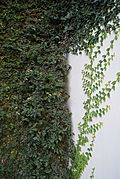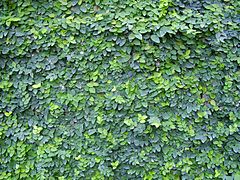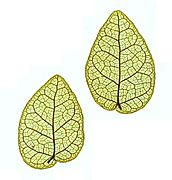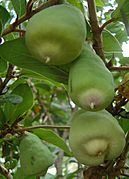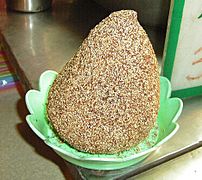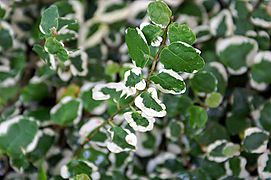Creeping fig facts for kids
Quick facts for kids Creeping fig |
|
|---|---|
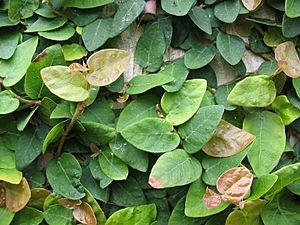 |
|
| F. pumila foliage | |
| Scientific classification | |
| Genus: |
Ficus
|
| Species: |
pumila
|
| Synonyms | |
|
List
Ficus hanceana Maxim.
Ficus longipedicellata H.Perrier Ficus pumila var. lutchuensis Koidz. Ficus repens var. lutchuensis Koidz. Ficus scandens Lam. Ficus stipulata Thunb. 1786 Ficus stipulata Lem. 1843 Ficus vestita Desf. Plagiostigma pumila Zucc. Plagiostigma stipulata Zucc. Tenorea heterophylla Gasp. Urostigma scandens (Lam.) Liebm. Varinga repens Raf. |
|
The creeping fig or climbing fig (scientific name: Ficus pumila) is a cool plant that flowers. It belongs to the mulberry family. This plant originally comes from East Asia, including China, Japan, and Vietnam. You can also find it growing wild in parts of the southeastern and south-central United States. Many people grow it as a houseplant too. The Latin word pumila means "dwarf." This name refers to the plant's very small leaves.
Contents
What Does the Creeping Fig Look Like?
The creeping fig is a woody plant that stays green all year. It's a type of liana, which means it's a vine that can climb. It can grow from about 2.5 to 4 meters tall. If you don't trim it, it can even reach up to 9 to 12 meters high!
When the plant is young, its leaves are much smaller and thinner. As it gets older, the leaves become larger. The leaves are shaped like an oval or a heart. They have veins that are opposite each other.
This plant can creep along the ground or climb up things. It uses special aerial roots to stick to trees, rocks, or walls. These roots release a sticky sap that helps the plant hold on tight.
How People Grow Creeping Fig
The creeping fig is known for its ability to creep and climb. People often use it in gardens to cover the ground. It also looks great climbing up walls and trees.
This plant can handle temperatures down to about 1 degree Celsius. It doesn't like frost, so in cooler places, it's usually grown indoors as a houseplant. It grows very fast and doesn't need much care.
Sometimes, if the conditions are just right, it can grow too much. Its roots can stick strongly to buildings. This might cause problems for older walls or structures made of weak materials.
The Royal Horticultural Society has given this plant an important award. It's called the Award of Garden Merit.
For the creeping fig to make seeds, it needs a special insect. This insect is a tiny fig wasp called Blastophaga pumilae. Also, the caterpillars of the Marpesia petreus butterfly like to eat this plant.
Different Types of Creeping Fig
There are a few different types and kinds of creeping fig:
- Ficus pumila var. awkeotsang — This one is called the awkeotsang creeping fig.
- Ficus pumila var. quercifolia — This type has leaves that look like oak leaves.
- Ficus pumila 'Curly' — This kind has crinkled or curly leaves.
- Ficus pumila 'Variegata' and Ficus pumila 'Snowflake' — These types have variegated leaves. This means their leaves have different colors or patterns.
Creeping Fig in Food
The fruit of the Ficus pumila var. awkeotsang is used to make a special food. In Taiwan, people turn the fruit inside out and dry it. Then, they scrape off the tiny seeds. A gel comes out from the seeds when mixed with water. This gel sets and becomes a jelly. It's known as aiyu jelly in Taiwan and ice jelly in Singapore.
Is Creeping Fig Safe?
Like other plants in the Moraceae family, the milky sap from the creeping fig can irritate your skin. If the sap gets on your skin and then you go into the sun, it can cause a rash or inflammation. This is called phytophotodermatitis. While the plant isn't considered poisonous to eat, it is listed in a database of plants to be careful with.
Gallery
See also
 In Spanish: Ficus pumila para niños
In Spanish: Ficus pumila para niños



